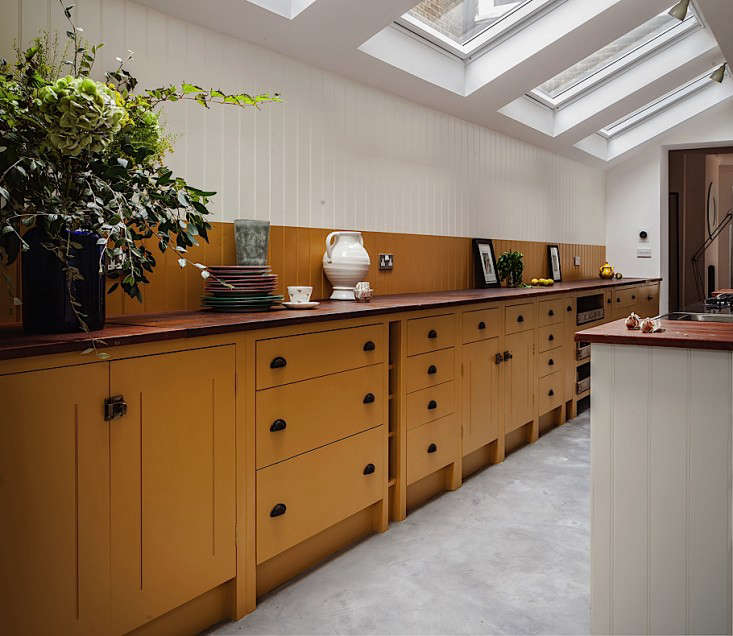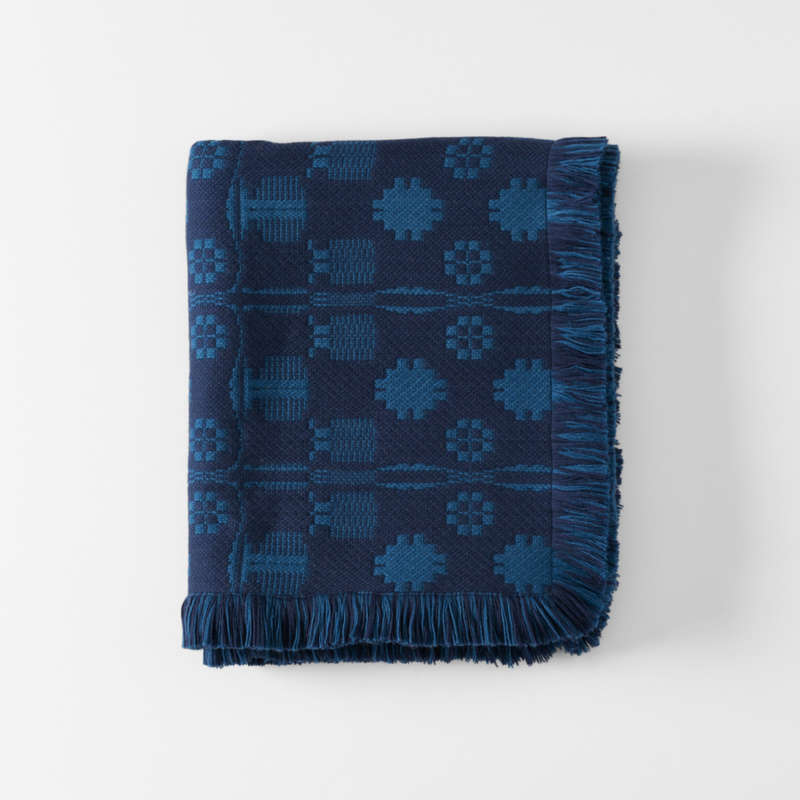You might not know the name (yet), but you’ve seen them: zellige tiles (also known as Moroccan tiles, zellige terracotta tiles, and zilij) are the trendiest tiles of 2019. We’ve seen them pop up everywhere we’ve looked the past few months, from a villa in France to a trendy house in Hudson to a cottage on Cape Cod. Their appeal? A handmade, slightly imperfect charm.
If you’re thinking about installing the tile of the moment in your house, there are a few things you should know—from how to tell if it’s the real thing to why it’s not ideal for perfectionists. Read on before installing:

1. It’s an ancestor of subway tile.
Zellige and subway tile seem worlds apart: one was created in 1904 for the New York City subway, the other dates to the 10th century in Morocco. But zellige was actually an early iteration of the ever-popular subway tile: both are ceramic tiles which have been fired and glazed. Read more in Remodeling 101: A Guide to the Only 7 Types of Tile You Need to Know.

2. It’s a prized (but dying) art.
The art of making zellige is passed from generation to generation in Morocco; master craftsmen are called maâlems. But even as it’s having a resurgence in interiors, it’s a dying craft, reports USA Today.
It’s laborious work. To make traditional zellige tiles, natural clay (usually from the area of Fez, Morocco) is mixed with water, hand-shaped, dried, and then kiln-fired, often using olive pits. Enamel glazing is then applied to the fronts of the tiles by hand. As with prized goods in other parts of the world (Champagne, Belgian linen), Morocco recently required that true zellige tiles be made from a clay without lime or iron, both of which can damage the tiles, and labeled accordingly.

3. No two tiles are alike.
Because they’re hand-molded, hand-cut, and hand-glazed, no two zellige tiles are exactly the same.

4. It can be hard to clean.
To note when considering zellige tiles for an interiors project: unlike manufactured, uniform factory tile, the handmade nature of zellige tiles results in imperfect, uneven shapes. Installed on a wall, the tiles appear more fluid or rippled than flat; corners and edges protrude rather than laying flush. This adds charm, but can make the tiles trickier to wipe down—and can also create a prime place for fabrics to snag.

5. It won’t be one uniform color.
Another side effect of zellige’s handmade charm: it’s impossible to get a batch of zellige tiles in the exact same hue. If you’re opting for zellige tiles in your project, know that your backsplash or wall will be more ombré or pointillist than solid-colored.
And, matte lovers beware: these tiles can be quite shiny. Clé Tile, who have a collection of zellige tiles, note that the tiles are “known for the sparkle and shine that comes from all their flaws and the wildly irregular shade variations of their drippy translucent glazes.”
6. But it’s possible to get “natural” zellige.
If you like a more bare look, you can get natural, unglazed zellige. Just be sure to wet the tiles before installing to prevent a “veil” of cement forming on the tiles, and use a grout with few additives. Which brings us to no. 7…

7. Now is not the time to DIY.
Installing zellige tile is tricky and requires special care. For best results, seek out an expert familiar with the tile—someone who pays close attention to detail.
8. The grout will be (nearly) invisible.
Experts recommend that zellige tiles be installed as close together as possible—with no joint and no tile spacers. Most installations include prepping the area with adhesive cement, placing the tiles, then skim-coating with a thin liquid joint cement or grout and wiping away the excess. The final look appears grout-less: a plus for those who are driven to madness by dirty grout, but a downside for those who like the look.

9. It’s not just for walls.
We’ve spotted zellige all over walls and kitchen backsplashes, but retailers say it can also be used on the floor in low-traffic areas (think: a guest bathroom). But be aware: walking on the floor (particularly with shoes on) may damage or scratch the tiles. Then again, it won’t be completely smooth (see: point no. 4), and walking on it without shoes could be uncomfortable.
10. If it doesn’t have imperfections, it’s not zellige.
A good way to tell whether your zellige is authentic or not? Look for tiny imperfections or variants among your tiles—a sure sign that, like true zellige, they were made by hand.

For much more on choosing tile (and taking care of it), see Remodeling 101: A Guide to the Only 7 Types of Tile You Need to Know, Everything You Always Wanted to Know About Grout and Caulk (but Were Afraid to Ask), and 7 Favorite Architect-Approved Sources for Subway Tile.
Lately, we’re revealing the things you might not know about common remodeling choices. Take a look:
- 10 Things Nobody Tells You About Renovating Your Bathroom
- 10 Things Nobody Tells You About the Benefits of Wool
- 10 Things Nobody Tells You About Clawfoot Bathtubs
- 10 Things Nobody Tells You About Painting Kitchen Cabinets
- 10 Things Nobody Tells You About Shiplap
- 10 Things Nobody Tells You About Marble Countertops
- 10 Things Nobody Tells You About Painting a Room White
Frequently asked questions
What are Moroccan zellige tiles?
Moroccan zellige tiles are handcrafted clay tiles traditionally made in Morocco. They are known for their vibrant colors, intricate patterns, and unique irregular shapes. Zellige tiles are typically glazed and have a glossy finish.
What are terracotta tiles?
Terracotta tiles are made from fired clay and have a natural, earthy appearance. They are known for their warm tones and rustic charm. Terracotta tiles can vary in color and texture, and they can be left unglazed or sealed for protection.
What are the pros of using Moroccan zellige tiles?
The pros of using Moroccan zellige tiles include:
Unique and intricate designs that add a distinct character to any space.
Vibrant colors that can create a lively and visually appealing atmosphere.
Handcrafted and artisanal qualities that make each tile unique.
Can be used on walls, floors, and even in wet areas like bathrooms and kitchens.
Glazed surface that is easy to clean and maintain.
What are the cons of using Moroccan zellige tiles?
The cons of using Moroccan zellige tiles include:
Irregular shapes that can make installation more challenging and time-consuming.
Higher cost compared to other tile options due to their artisanal craftsmanship.
The glaze may develop fine cracks or crazing over time, adding to their aged and weathered look.
What are the pros of using terracotta tiles?
The pros of using terracotta tiles include:
Warm and inviting appearance that adds a rustic charm to any space.
Versatility to be used in various design styles, including Mediterranean, farmhouse, or bohemian.
Durable and long-lasting, especially when properly sealed and maintained.
Natural variations in color and texture that create a unique and authentic look.
What are the cons of using terracotta tiles?
The cons of using terracotta tiles include:
Porous nature that requires regular sealing to prevent staining and water damage.
Susceptibility to scratches and chips, particularly if not properly maintained.
Limited color options compared to glazed tiles.
More labor-intensive installation process due to the need for sealing and potential variation in tile thickness.
How do I clean and maintain Moroccan zellige tiles?
To clean and maintain Moroccan zellige tiles:
Use a non-abrasive, pH-neutral cleaner and a soft cloth or mop.
Avoid harsh chemicals or abrasive scrubbing pads that may damage the glaze.
Regularly wipe up spills and stains to prevent them from seeping into the grout or glaze.
Follow the manufacturer's recommendations for sealing and resealing.




Have a Question or Comment About This Post?
Join the conversation